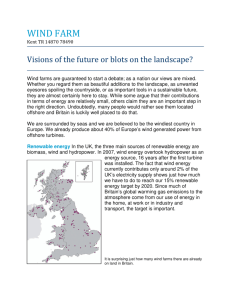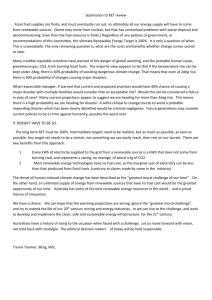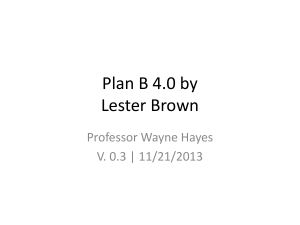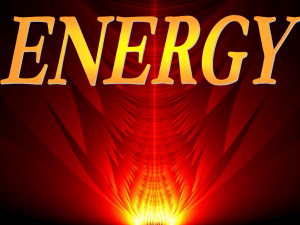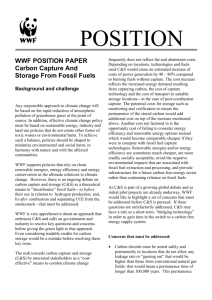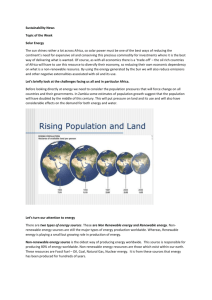finance-re - RETD | Renewable Energy Technology Deployment
advertisement
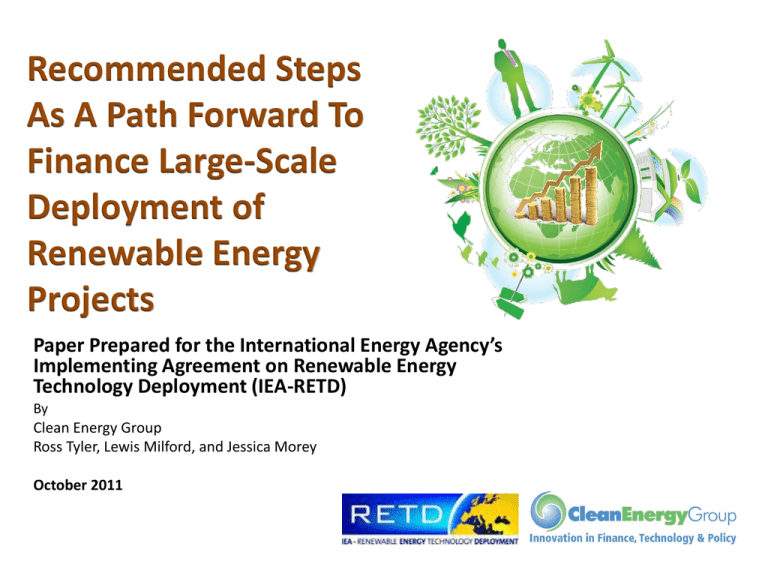
Recommended Steps As A Path Forward To Finance Large-Scale Deployment of Renewable Energy Projects Paper Prepared for the International Energy Agency’s Implementing Agreement on Renewable Energy Technology Deployment (IEA-RETD) By Clean Energy Group Ross Tyler, Lewis Milford, and Jessica Morey October 2011 Take-Away Themes from Report • Existing finance mechanisms alone will not attract huge quantities of needed new investment capital • Need to access new capital by reducing risk-toreward ratio, showing potential profit to investors • New approaches needed to: 1. Combine support mechanisms with new financial products, possibly under management of national infrastructure bank 2. Bring together job creation, finance, innovation, and policies for energy security, national economic recovery, and sustained competitiveness 2 Challenges • New renewable energy technologies face higher capital costs associated high risk, and they compete the entrenched infrastructure from incumbent fossil fuel system. • Solutions to the renewable energy finance challenge could be found in tools used by complex, non-energy sectors, including public and private approaches • Consider framing the clean energy challenge as a 50+ year infrastructurebuilding challenge that will lead to economic recovery and national competitiveness. 3 Context • IPCC SRREN estimates global renewable energy investment approximates to US$600-700 BILLON per year. • It’s a lot but not insurmountable when viewed as 1% GDP or when US corporations have US$1.8 trillion on balance sheets. • Problem: Investors are in “wait and see” mode, which could potentially lock-out clean energy. 4 Obstacles to Clean Energy Investment 1. 2. 3. 4. Perceived cost disadvantage to fossil fuel technologies Intermittent resources require enabling technologies Limitations of existing transmission grids Matching funding sources to risk-to-reward profiles along the clean energy continuum. 5. Real world economic recessions and national deficits 6. Embedded institutional relationships supporting incumbent fossil fuel technologies and potential to “lock-out” clean energy technologies. 7. Market failures such as un-priced carbon emissions 5 Obstacles to Clean Energy Investment cont’d Technological and Competitive Risks, when combined with market failures such as un-priced carbon emissions, bring investment obstacles including: – – – – – – Uncertainty over long-term policies Large upfront asset costs Restricted lending by banks High transaction costs Inflated costs to cover unknown or risk contingencies Burdening with additional costs from interconnections and construction facilities (e.g., vessels for offshore wind) 6 Overarching Recommendation Consideration given to strategies that reflect the following goals: • Recast public support around a new, national, economic development initiative • Design policies to improve the risk-to-reward ratio in new energy infrastructure. 7 Well Developed Public Support and Finance Mechanisms • Price-Based Instruments • Quantity-Based Instruments • Investment Subsidies • Financial Institution Partnership Programs • Complementary Tax Measures 8 Other Sources of Funding • Pension funds: P8 Groups with USD $3.5 trillion • Sovereign Funds: top 10 with USD $3.8 trillion • Insurance Funds: potentially could be tapped with tax credit incentives • Profitable Corporations: making use of Tax Equity Incentives, e.g. Google. 9 Basis for Plausible Solutions Incorporate and integrate four kinds of pubic and private approaches for clean energy: 1. 2. 3. 4. Economic Development Financial Innovation Innovation Strategies Enabling Energy Policies 10 Clean Energy as a NEW Economic Development System • Consider replication of some clean energy economic development practices adopted by some leading nations. • Some Asian economies place emphasis on clean energy support as a new form of national industrial policy. • Others are beginning to follow with concentration on clean energy industry support, e.g., UK – Offshore wind. 11 Finance • Institutionalize financing in a planned manner that builds national/regional clean energy infrastructures vs. a number of individual projects. • Existing successful practices found in: European Investment Bank, Germany’s KfW, Marguerite’s 2020 European Fund for Energy, and now UK proposing the National Green Investment Bank (GIB): – Proposed early launch (incubator) to give investor confidence – Public funds as seed and leveraged (first loss position) – Free standing run as private enterprise and advises the government – Offering products that match investor appetite to sources: e.g., higher returns for high risk construction phase with prearranged refinancing of lower returns for O&M phase. 12 Finance cont’d UK GIB is proposing total financial solutions to include transmission, interconnection, and installation vessels (offshore wind) 1. Leverage public funding 2. Risk-adjusted to reward ratio 3. Recycle investment funds 4. Explore green bonds 5. Provide or increase export credit assistance 13 Innovation • Support systems innovation along the clean energy value chain from lab to product development and business formats to financial models. • Governments could encourage “open and distributed” innovation to tap dispersed global talent and to collaborate across institutions. • Look to “reverse innovation” strategies and partnerships for designing, creating, and manufacturing clean energy technologies in developing countries at low cost, and then adapt and export to OECD countries • Use “Distributed Innovation” to form public-private networks for accelerated and leveraged R&D, e.g., Marie Curie EU FP7, UK Carbon Trust Wind Accelerator, and US SEMATECH 14 Enabling Energy Policies Focus on policies that support scaling up existing technologies and new breakthroughs that contribute to achieving national clean energy goals. 1. Scale-up of Existing Technologies 2. Support Emerging Technologies 15 Conclusion • This is the time to apply the critical knowledge gained over the last two decades in order to attract step-change finance for the accelerated large-scale deployment of renewable energy projects. • Need to consider it as national/regional, long-term, infrastructure building exercises vs. series of un-related individual large projects. • Public leaders tempted with cut-backs might consider alternative of policies and institutions to increase public-funding leverage to target and unleash the large pools of private capital. • The suite of policies should align and integrate strategies for creating a new clean energy infrastructure and a robust economy with long-term job generation, improved and lower cost technologies, better climate, energy security, and raised national competitiveness. 16 Contact Ross Tyler – rtyler@cleanegroup.org Lewis Milford – lmilford@cleanegroup.org Clean Energy Group 50 State Street, Suite 1 Montpelier, VT 05602 USA Tel: 00 1 802 223 2554 17


